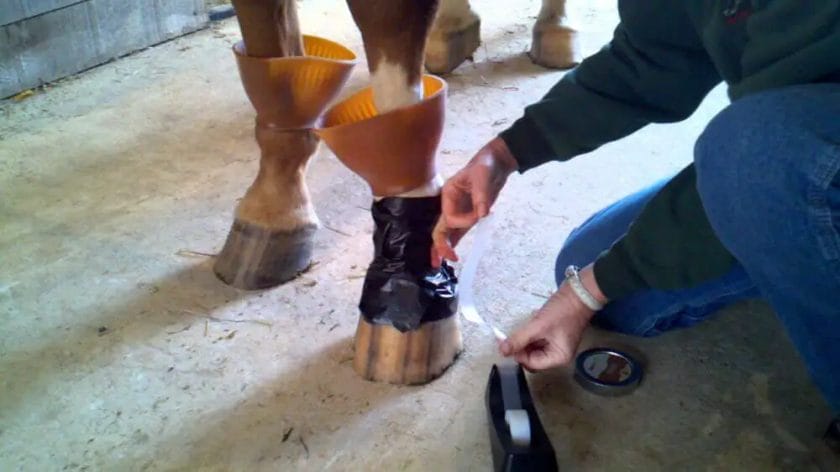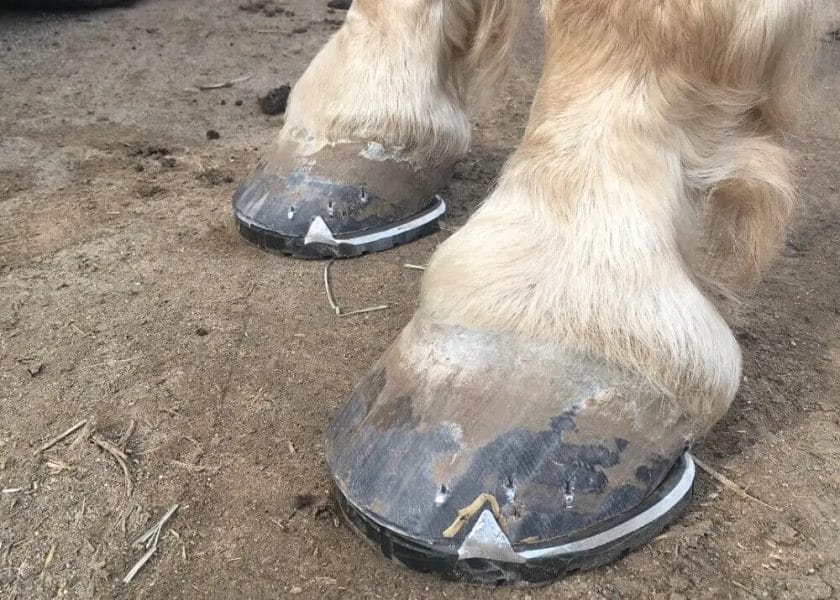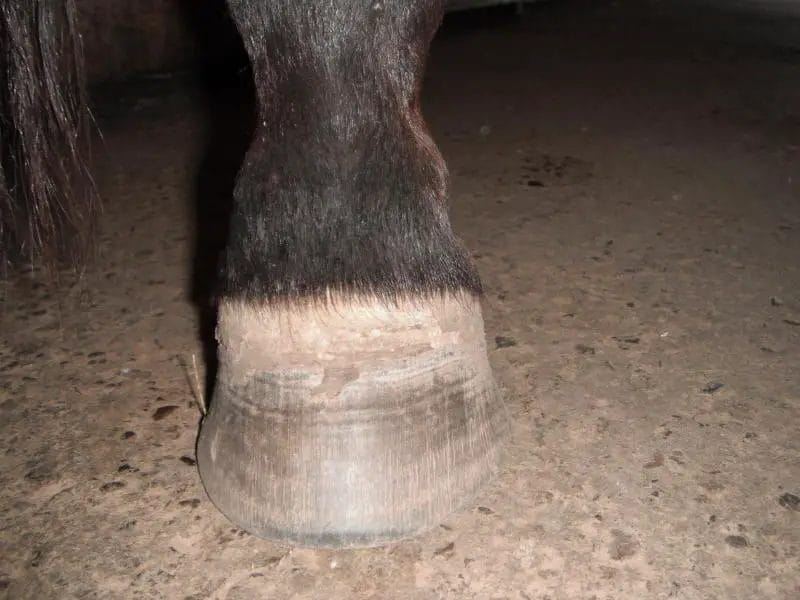If you’re considering buying a horse with sidebone, it’s important to understand the implications and potential challenges that may come with this condition. Sidebone, also known as ossification of the lateral cartilages, is a condition where the cartilages in the hoof become hardened and bony. While it may not always cause lameness or affect a horse’s performance, it’s essential to thoroughly evaluate the horse’s soundness and consult with a veterinarian before making a decision. Understanding the long-term management and potential effects on the horse’s well-being is crucial to ensure a successful partnership.

Evaluating the Pros and Cons of Buying a Horse with Sidebone
Before purchasing a horse, it is important to consider all aspects of the horse’s health and soundness. One condition that potential buyers may come across is sidebone. Sidebone is a degenerative condition that affects the collateral cartilages in the horse’s foot. It can have a significant impact on the horse’s overall soundness and athletic ability.
What is Sidebone?
Sidebone is the calcification or hardening of the collateral cartilages in a horse’s foot. These cartilages run alongside the hoof wall and provide support and flexibility to the foot. When they become calcified, they lose their ability to flex and absorb shock, leading to potential lameness and decreased performance.
The Pros of Buying a Horse with Sidebone
While sidebone may raise concerns for some buyers, there are certain advantages to purchasing a horse with this condition:
- Reduced Purchase Price: Horses with sidebone often have a lower market value compared to sound horses. If you are on a budget or looking for a horse in a lower price range, this can be an opportunity to find a suitable mount within your financial means.
- Disclosed Condition: When purchasing a horse, it is important to have all the necessary information about their health and soundness. If the seller discloses that the horse has sidebone, you have the advantage of knowing about the condition upfront and can make an informed decision based on your requirements.
- Potential for Light Work: While sidebone can limit a horse’s athletic abilities, it does not necessarily mean the horse cannot be ridden or used for light work. With proper management and veterinary care, some horses with sidebone can continue to lead a comfortable and fulfilling life.
The Cons of Buying a Horse with Sidebone
Despite the potential advantages, it is essential to consider the downsides of purchasing a horse with sidebone:
- Limited Performance: Sidebone can affect the horse’s range of motion and flexibility, which can have a negative impact on their performance. If you are looking for a competitive mount or a horse for high-intensity activities, the limitations imposed by sidebone may not be suitable.
- Potential for Lameness: Horses with sidebone are more prone to lameness issues. The condition can lead to chronic pain, inflammation, and lameness, requiring ongoing veterinary care and management.
- Resale Challenges: If you plan on selling the horse in the future, having a horse with sidebone may limit your potential buyer pool. Many buyers may be hesitant to invest in a horse with a pre-existing condition, reducing the chances of a profitable resale.
In summary, buying a horse with sidebone comes with its own set of pros and cons. It is crucial to carefully evaluate the horse’s current condition, consider your intended use for the horse, and consult with a veterinarian before making a purchase decision. While a horse with sidebone may be suitable for certain individuals and disciplines, it may not be the right choice for others. Ultimately, it is essential to prioritize the horse’s well-being and long-term soundness when considering a horse with sidebone.

The Importance of Pre-Purchase Examinations for Horses with Sidebone
When considering the purchase of a horse, it is vital to conduct a thorough pre-purchase examination to ensure the animal’s soundness and overall health. This becomes even more crucial when dealing with horses that have a history of sidebone. Sidebone is a condition where the lateral cartilages in a horse’s foot become mineralized and turn to bone. This can affect the horse’s movement and soundness, making it essential to assess the severity of the condition before committing to a purchase.
During a pre-purchase examination, a veterinarian will assess various aspects of the horse’s health, including its conformation, gait, and overall soundness. With a horse that has sidebone, specific attention needs to be given to the foot and the affected cartilages. The veterinarian will closely examine the hoof and assess any signs of lameness or discomfort. They may also utilize diagnostic imaging techniques such as X-rays to get a clearer picture of the extent of the sidebone.
By conducting a pre-purchase examination, potential buyers can gain valuable insights into the horse’s condition and future soundness. Here are some key reasons why pre-purchase examinations are crucial for horses with sidebone:
1. Assessing Soundness:
A pre-purchase examination allows the veterinarian to evaluate the horse’s overall soundness, identifying any potential issues that may affect performance or longevity. This is particularly important for horses with sidebone, as it can impact their movement and comfort. The examination helps the buyer make an informed decision about the horse’s suitability for their intended use, whether it be for recreational riding or competitive sports.
2. Understanding the Severity of Sidebone:
Through diagnostic imaging techniques, such as X-rays, veterinarians can assess the severity of the sidebone. This information is crucial for determining the horse’s prognosis and potential for future lameness. By understanding the extent of the condition, buyers can make informed decisions about the horse’s long-term care and management.
3. Planning for Management and Treatment:
Pre-purchase examinations provide buyers with valuable information on how to manage and treat a horse with sidebone. The veterinarian can provide recommendations on appropriate hoof care, shoeing techniques, and therapeutic interventions that can help alleviate discomfort and maintain the horse’s soundness. Having this information upfront allows potential buyers to evaluate the potential costs and responsibilities associated with owning a horse with sidebone.
4. Negotiating the Purchase Price:
A pre-purchase examination can also provide buyers with leverage when negotiating the purchase price of a horse with sidebone. If the examination reveals significant issues or potential future complications, buyers may have grounds to request a lower price or additional veterinary assurances before finalizing the purchase.
5. Protecting the Buyer’s Investment:
Investing in a horse is a significant financial commitment, and conducting a pre-purchase examination is a crucial step in protecting that investment. By thoroughly assessing the horse’s health and soundness, buyers can minimize the risk of purchasing a horse with underlying issues that may require costly treatments or compromise its performance.
In summary, pre-purchase examinations are of utmost importance when considering the purchase of a horse with sidebone. These thorough examinations provide crucial insights into the horse’s soundness, severity of the condition, management requirements, and potential for future issues. By conducting a pre-purchase examination, buyers can make informed decisions, negotiate prices, and protect their investment in the long run.

Managing and Treating Sidebone in Horses: Tips and Strategies
Sidebone is a common condition in horses that occurs when the cartilage in the hoof becomes ossified or turns to bone. This can cause discomfort and lameness in affected horses, making it essential for horse owners and caretakers to understand how to manage and treat sidebone effectively. In this section, we will explore some tips and strategies for managing and treating sidebone in horses.
1. Proper Hoof Care
One of the most crucial aspects of managing sidebone in horses is maintaining proper hoof care. Regular and attentive hoof trimming can help alleviate the symptoms associated with sidebone and prevent further complications. Trimming the hoof correctly can promote balanced weight distribution and reduce strain on the affected area.
It is recommended to consult with an experienced farrier or veterinarian to determine the appropriate trimming schedule and technique for your horse with sidebone. They can provide valuable insights and ensure that the hooves are trimmed correctly to maximize comfort and support for the affected area.
2. Balanced Exercise
Exercise plays a vital role in managing sidebone in horses. While it is essential to provide regular exercise to keep the horse in good overall condition, it is equally important to ensure that the exercise is balanced and suitable for the horse’s condition.
Activities that involve excessive strain or impact on the hooves, such as jumping or hard galloping on uneven surfaces, should be avoided or minimized. Instead, focus on low-impact exercises, such as walking and controlled trotting on soft and even surfaces. These exercises help maintain joint flexibility and improve blood circulation without putting excessive stress on the affected area.
3. Supportive Shoeing
In some cases, supportive shoeing techniques can be beneficial for horses with sidebone. The use of specialized shoes, such as bar shoes or shoes with a rolled toe, can provide additional support and reduce pressure on the affected area.
It is crucial to work with a skilled farrier who has experience in dealing with sidebone and understands the specific shoeing requirements for your horse. They can help determine the most suitable shoeing approach and ensure that the shoes are properly fitted to maximize the therapeutic benefits.
4. Veterinary Intervention
If the symptoms of sidebone persist or worsen despite proper management strategies, it may be necessary to seek veterinary intervention. A veterinarian can assess the severity of the sidebone and recommend additional treatment options to alleviate discomfort and manage the condition effectively.
Treatment options may include anti-inflammatory medications, joint supplements, or even advanced therapies such as shockwave therapy or stem cell treatment, depending on the individual case. It is essential to follow the veterinarian’s guidance closely and provide any necessary follow-up care to ensure the best possible outcome for the horse.
5. Nutritional Support
Nutrition also plays a vital role in managing sidebone in horses. Providing a balanced diet with appropriate levels of essential nutrients, including vitamins and minerals, can contribute to overall hoof health and support the healing process.
Consulting with a knowledgeable equine nutritionist or veterinarian can help determine the most suitable diet for a horse with sidebone. They can recommend appropriate supplements and adjustments to the feeding regimen to ensure optimal nutritional support and promote hoof integrity.
6. Regular Monitoring and Follow-Up
Lastly, regular monitoring and follow-up are crucial in managing sidebone in horses. Keep a close eye on your horse’s behavior, gait, and overall comfort level. If any changes or worsening of symptoms are noticed, promptly consult with a veterinarian for further evaluation and adjustment of the management plan.
Periodic radiographic evaluations may also be recommended to monitor the progression of sidebone and ensure appropriate management strategies are in place.
Summary
Managing and treating sidebone in horses requires a comprehensive approach involving proper hoof care, balanced exercise, supportive shoeing, veterinary intervention when necessary, nutritional support, and regular monitoring. By implementing these tips and strategies, horse owners and caretakers can help alleviate discomfort, manage the condition effectively, and enhance the overall well-being of the affected horse.
Alternative Options for Horse Buyers: Considering Horses without Sidebone
When it comes to purchasing a horse, there are several factors that need to be taken into consideration. One such factor is the horse’s soundness and overall health. Sidebone is a condition that affects the horse’s foot and can potentially cause lameness. However, it is important to note that not all horses with sidebone experience lameness or have their performance affected. In this section, we will explore alternative options for horse buyers who are considering horses without sidebone.
1. Thorough Pre-Purchase Examination
Before buying any horse, it is crucial to conduct a thorough pre-purchase examination. This examination includes a comprehensive evaluation of the horse’s overall health, conformation, and soundness. While sidebone may be a concern, it should not be the sole determining factor in the decision-making process. A qualified veterinarian can provide insight into the severity of the sidebone and its potential impact on the horse’s performance.
During the examination, the veterinarian will assess the horse’s gait, hoof condition, and any signs of lameness. They may also request radiographs (X-rays) of the horse’s foot to determine the extent of the sidebone. Based on these findings, the veterinarian can provide an informed opinion on the horse’s suitability for the intended use.
2. Consider the Horse’s History
When evaluating a horse with sidebone, it is essential to consider their previous performance and work history. Some horses with sidebone may have had successful careers without any detrimental effects on their performance. This information can be obtained by consulting with the previous owner, trainer, or reviewing competition records.
Additionally, it is important to determine if the horse has received appropriate management and care for their sidebone condition. Proper hoof care, regular farrier visits, and correct shoeing can help alleviate any potential discomfort associated with sidebone.
3. Seek Professional Guidance
For horse buyers who are unsure about the implications of sidebone, seeking guidance from an experienced equine professional can be beneficial. Trainers, instructors, and equine veterinarians with expertise in evaluating horses can provide valuable insight and advice. They can assess the horse’s overall suitability for the intended discipline, taking into account the presence of sidebone.
Professional guidance can help buyers make an informed decision and identify any potential red flags that may indicate future soundness issues. It is important to work with individuals who have a solid understanding of the specific discipline in which the horse will be utilized.
4. Consider Prevention and Management
While it is advisable to approach horses with sidebone with caution, it is worth noting that proper prevention and management strategies can contribute to the horse’s overall soundness and well-being. Regular exercise, appropriate footing, and a balanced diet can help optimize the horse’s health and reduce the risk of any lameness issues associated with sidebone.
Consulting with a veterinarian or equine specialist can provide valuable recommendations for preventive measures and management techniques specific to the horse’s individual needs. These measures can help maintain the horse’s performance and reduce the likelihood of sidebone-related complications.
5. Explore Other Horse Options
Lastly, if the presence of sidebone is a significant concern or if the buyer does not feel comfortable proceeding with a horse affected by this condition, it may be necessary to explore other horse options. There are countless horses available on the market, and finding a suitable horse for the intended purpose is achievable.
By expanding the search criteria, considering different breeds or disciplines, and working closely with professionals, horse buyers can find a horse that meets their requirements without the presence of sidebone.
Summary
While sidebone can be a potential concern for horse buyers, it should not automatically exclude a horse from consideration. A thorough pre-purchase examination, consideration of the horse’s history, seeking professional guidance, implementing preventive measures, and exploring alternative options are all strategies that can assist buyers in making an informed decision. By carefully evaluating the overall suitability and soundness of the horse, buyers can find a suitable horse without sidebone that meets their needs and can perform well in their desired discipline.
FAQs
1. Is it advisable to buy a horse with sidebone?
It is generally not recommended to buy a horse with sidebone. Sidebone is a condition where the cartilage in the horse’s hoof turns bony, leading to potential lameness and soundness issues. It is best to consult with a veterinarian before making a decision.
2. What are the potential risks of owning a horse with sidebone?
Owning a horse with sidebone can pose a risk as it may lead to lameness and decreased performance. The bony growth can affect the horse’s movement and cause discomfort. Regular monitoring and proper management are required to minimize the potential risks.
3. How can sidebone be managed in horses?
Managing sidebone in horses involves a combination of proper hoof care, regular exercise, and veterinary supervision. Techniques such as corrective shoeing and specialized trimming may help alleviate symptoms. Consultation with a veterinarian and a knowledgeable farrier is crucial for effective management.
Conclusion
In conclusion, when considering whether to buy a horse with sidebone, there are several factors to take into account. While sidebone can potentially cause lameness and discomfort, it doesn’t necessarily mean that the horse will be unsuitable for riding or other activities. Proper management and veterinary care can help alleviate the symptoms and ensure the horse’s well-being. Additionally, the horse’s temperament, conformation, and overall soundness should also be evaluated. It’s important to seek advice from a trusted veterinarian and consider your own riding goals and capabilities before making a decision.
